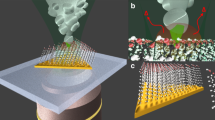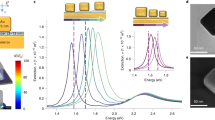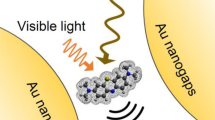Abstract
The fields of plasmonics, Raman spectroscopy and atomic force microscopy have recently undergone considerable development, but independently of one another. By combining these techniques, a range of complementary information could be simultaneously obtained at a single molecule level. Here, we report the design, fabrication and application of a photonic–plasmonic device that is fully compatible with atomic force microscopy and Raman spectroscopy. Our approach relies on the generation and localization of surface plasmon polaritons by means of adiabatic compression through a metallic tapered waveguide to create strongly enhanced Raman excitation in a region just a few nanometres across. The tapered waveguide can also be used as an atomic force microscope tip. Using the device, topographic, chemical and structural information about silicon nanocrystals may be obtained with a spatial resolution of 7 nm.
This is a preview of subscription content, access via your institution
Access options
Subscribe to this journal
Receive 12 print issues and online access
$259.00 per year
only $21.58 per issue
Buy this article
- Purchase on Springer Link
- Instant access to full article PDF
Prices may be subject to local taxes which are calculated during checkout






Similar content being viewed by others
References
Raether, H. Surface Plasmons (Springer, 1988).
Masuhara, H. & Kawata, S. (eds) Nanoplasmonics Vol. 2 (Elsevier, 2006).
Murray, W. A. & Barnes W. L. Plasmonic materials. Adv. Mater. 19, 3771–3782 (2007).
Kino, G. Tuning into optical wavelengths. Nature Photon. 2, 210–211 (2008) and references therein.
Zheludev, N. I. What diffraction limit? Nature Mater. 7, 420–422 (2008).
Zhang, X. & Liu, Z. Superlenses to overcome the diffraction limit. Nature Mater. 7, 435–441 (2008).
Anker, J. N. et al. Biosensing with plasmonic nanosensors. Nature Mater. 7, 442–453 (2008).
Barnes, W. L., Dereux, A. & Ebbesen, T. W. Surface plasmon subwavelength optics. Nature 424, 824–830 (2003).
Prodan, E., Radloff, C., Halas, N. J. & Nordlander, P. A hybridization model for the plasmon response of complex nanostructures. Science 302, 419–422 (2003).
Verhagen, E., Kuipers, L. & Polman, A. Enhanced nonlinear optical effects with a tapered plasmonic waveguide. Nano Lett. 7, 334–337 (2007).
Taminiau, T. H., Stefani, F. D., Segerink, F. B. & Van Hulst, N. F. Optical antennas direct single-molecule emission. Nature Photon. 2, 234–237 (2008).
Merlein, J. et al. Nanomechanical control of an optical antenna. Nature Photon. 2, 230–233 (2008).
Zenobi, R. Analytical tools for the nano world. Anal. Bioanal. Chem. 390, 215–221 (2008).
Gerhardt, I. et al. Scanning near-field optical coherent spectroscopy of single molecules at 1.4 K. Opt. Lett. 32, 1420–1422 (2007).
Hartschuh, A., Pedrosa, H. N., Novotny, L. & Krauss, T. D. Simultaneous fluorescence and Raman scattering from single carbon nanotubes. Science 301, 1354–1356 (2003).
Di Fabrizio, E. et al. Procedimenti di fabbricazione di un dispositivo a crista llo fotonico provvisto di guida d'onda plasmonica. Italian patent TO2008A000693 (2008).
Andreani, L. C. & Gerace, D. Photonic crystal slabs with a triangular lattice of triangular holes investigated using a guided-mode expansion method. Phys. Rev. B 73, 235114 (2006).
De Angelis, F. et al. Hybrid plasmonic–photonic nanodevice for label-free few/single molecule detection in the far field. Nano Lett. 8, 2321–2327 (2008).
Stockman, M. I. Nanofocusing of optical energy in tapered plasmonic waveguides. Phys. Rev. Lett. 93, 137404 (2004).
Babadjanian, A. J., Margaryan, N. L. & Nerkararyan, V. Superfocusing of surface polaritons in the conical structure. J. Appl. Phys. 87, 3785–3793 (1999).
Anderson, M. S. Locally enhanced Raman spectroscopy with an atomic force microscope. Appl. Phys. Lett. 76, 3130–3133 (2000).
Hayazawa, N., Inouye, Y., Sekkat, Z. & Kawata, S. Metallized tip amplification of near-field Raman scattering. Opt. Commun. 183, 333–336 (2000).
Stöckle, R. M., Suh, Y. D., Deckert, V. & Zenobi, R. Nanoscale chemical analysis by tip-enhanced Raman spectroscopy. Chem. Phys. Lett. 318, 131–136 (2000).
Hartschuh, A., Sanchez, E. J., Xie, X. S. & Novotny, L. High-resolution near-field Raman microscopy of single-walled carbon nanotubes. Phys. Rev. Lett. 90, 095503 (2003).
Hu, D. H., Micic, M., Klymyshyn, N., Suh, Y. D. & Lu, H. P. Correlated topographic and spectroscopic imaging by combined atomic force microscopy and optical microscopy. J. Lumin. 107, 4–12 (2004).
Anderson, N., Anger, P., Hartschuh, A. & Novotny, L. Subsurface Raman imaging with nanoscale resolution. Nano Lett. 6, 744–749 (2006).
Mchedlidze, T. et al. Light-induced solid-to-solid phase transformation in Si nanolayers Si–SiO2 multiple quantum wells. Phys. Rev. B 77, 161304 (2008).
Richter, H., Wang, Z. P. & Ley, L. The one phonon Raman spectrum in microcrystalline silicon. Solid State Commun. 39, 625–629 (1981).
dos Santos, D. R. & Torriani, I. L. Crystallite size determination in μc–Ge films by X-ray diffraction and Raman line profile analysis. Solid State Commun. 85, 307–309 (1993).
Kohno, H., Iwasaki, T., Mita, Y. & Takeda, S. One-phonon Raman scattering studies of chains of crystalline-Si nanospheres. J. Appl. Phys. 91, 3232–3235 (2002).
Fauchet, P. H. & Campbell, I. H. Raman spectroscopy of low dimensional semiconductors. Crit. Rev. Solid State Mater. Sci. 14, S79–S101 (1988).
Rojas, S., Zanotti, L., Borghesi, A., Sasella, A. & Pignatel, G. U. Characterization of silicon dioxide and phosphosilicate glass deposited films. J. Vac. Sci. Technol. B 11, 2081–2089 (1993).
Daldosso, N. et al. Silicon nanocrystal formation in annealed silicon-rich silicon oxide films prepared by plasma enhanced chemical vapor deposition. J. Appl. Phys. 101, 113510 (2007).
Khriachtchev, L., Rasanen, M. & Novikov, S. Laser-controlled stress of Si nanocrystals in a free-standing Si/SiO2 superlattice. Appl. Phys. Lett. 88, 013102 (2006).
Acknowledgements
This work was funded under European Project DIPNA FP6-STREP proposal no. 032131, Project SMD FP7-NMP 2800-SMALL-2 proposal no. CP-FP 229375-2, MIUR-PRIN2008 project—Italian Ministry of University and Research, FIRB contract no. RBAP06L4S5, Fondazione Cariplo project 2007-5259, and project POSEIDON under POR Calabria 2006-2008. M.L. and A.B. acknowledge funding from FP6-BINASP-SSA011936 project.
Author information
Authors and Affiliations
Contributions
All authors contributed significantly to the work presented in this paper.
Corresponding author
Supplementary information
Supplementary information
Supplementary information (PDF 2393 kb)
Supplementary information
Supplementary movie 1 (MOV 4827 kb)
Supplementary information
Supplementary movie 2 (MOV 2872 kb)
Rights and permissions
About this article
Cite this article
De Angelis, F., Das, G., Candeloro, P. et al. Nanoscale chemical mapping using three-dimensional adiabatic compression of surface plasmon polaritons. Nature Nanotech 5, 67–72 (2010). https://doi.org/10.1038/nnano.2009.348
Received:
Accepted:
Published:
Issue Date:
DOI: https://doi.org/10.1038/nnano.2009.348
This article is cited by
-
Recent advances in tip-enhanced Raman spectroscopy probe designs
Nano Research (2023)
-
Near-unity Raman β-factor of surface-enhanced Raman scattering in a waveguide
Nature Nanotechnology (2022)
-
A dual-use probe for nano-metric photoelectric characterization using a confined light field generated by photonic crystals in the cantilever
Nano Research (2021)
-
Near Field Differential Interference Contrast Microscopy
Scientific Reports (2020)
-
Non-locality by nanoconfinement
Nature Nanotechnology (2019)



